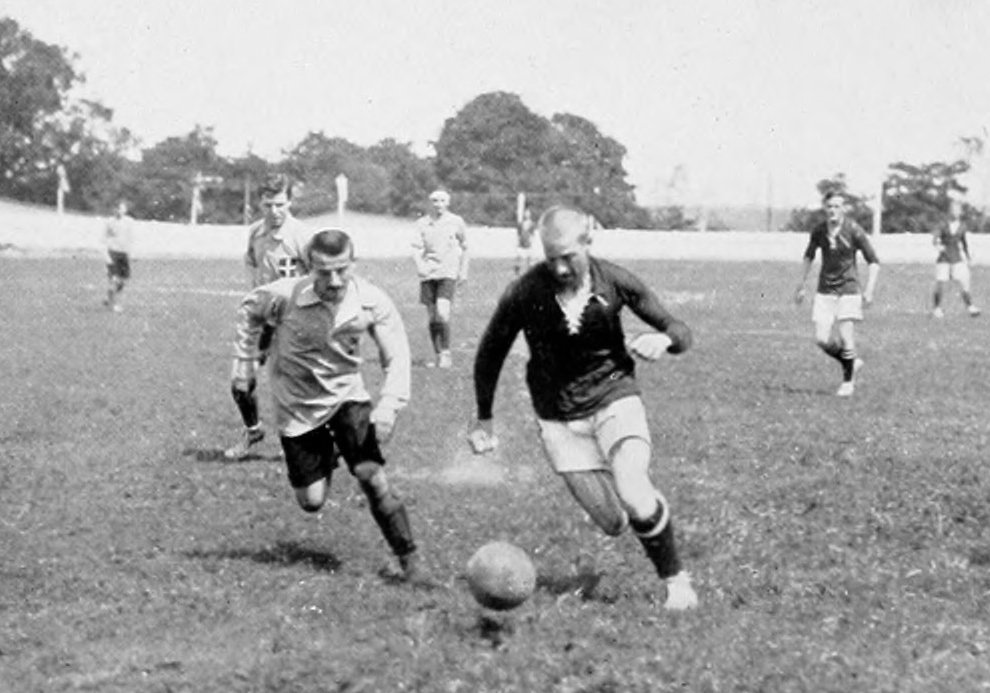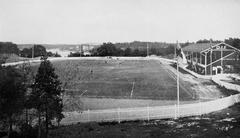
Tranebergs Idrottsplats: Visiting Hours, Tickets, and Your Guide to Stockholm’s Historic Sports Venue
Date: 14/06/2025
Introduction: Why Tranebergs Idrottsplats Matters
Tranebergs Idrottsplats stands as a significant chapter in Stockholm’s sporting and cultural history. Established in 1911, this historic stadium was once the home of Djurgårdens IF and played a notable role as one of the football venues during the 1912 Summer Olympics. While the original structure no longer exists, the site—now a public park adorned with commemorative plaques and remnants—remains a cherished landmark. Here, visitors encounter a unique blend of sporting heritage, community spirit, and scenic beauty, making Tranebergs Idrottsplats an essential stop for sports fans, history enthusiasts, and curious travelers alike.
For further information, consult official and authoritative sources such as Visit Stockholm and Olympedia.
Table of Contents
- Introduction
- Origins and Construction
- Djurgårdens IF and the Stadium’s Golden Era
- Olympic Legacy: The 1912 Summer Games
- Architectural Features and Atmosphere
- Closure, Demolition, and Today’s Park
- Cultural and Historical Significance
- Practical Visitor Information
- Frequently Asked Questions (FAQ)
- Conclusion
- References
Origins and Construction
Tranebergs Idrottsplats was constructed in response to Stockholm’s burgeoning football scene in the early 20th century. When Djurgårdens IF sought a dedicated ground, the city offered land near Tranebergsbron (Traneberg Bridge). Crown Prince Gustaf Adolf inaugurated the stadium in September 1911. Its first match—Djurgården’s 3–1 victory over AIK—drew 1,659 spectators and marked the beginning of a new era for both the club and the district.
Djurgårdens IF and the Stadium’s Golden Era
Between 1911 and 1935, Tranebergs Idrottsplats served as the primary home ground for Djurgårdens IF. The stadium supported regular league fixtures, training, and fostered a loyal local fanbase. While major matches often moved to the larger Stockholm Olympic Stadium after 1912, Tranebergs Idrottsplats remained the heart of Djurgården’s community and a cradle for football development in Stockholm.
Olympic Legacy: The 1912 Summer Games
As one of the official football venues for the 1912 Stockholm Olympics, Tranebergs Idrottsplats hosted three matches. Historic moments, such as Finland’s victories over Italy and Russia, unfolded here, enhancing Sweden’s international sporting reputation. A commemorative plaque on-site today honors its role as a “Sports Historical Monument from the 1912 Olympics” (Olympedia).
Architectural Features and Atmosphere
The original stadium boasted a main stand for 2,000 spectators and terraces raising capacity to about 10,000. Its design reflected early 20th-century Swedish sports architecture—simple, functional, and community-focused. While most of the structures are gone, remnants like the distinctive stone wall still evoke the passionate atmosphere once fueled by local supporters from Stockholm’s working-class neighborhoods.
Closure, Demolition, and Today’s Park
Djurgårdens IF’s lease ended in 1935, coinciding with city plans for residential development. Instead, the former stadium site was transformed into a public park, preserving green space for community use. Visitors can now freely explore the park, view commemorative plaques, and reflect on the sporting history embedded in the landscape.
Visiting Hours and Access
- Open: Year-round, daily from dawn to dusk.
- Entry: Free, no ticket required.
- Access: Reachable via Stockholm Metro (Alvik station), followed by a short walk toward Tranebergsbron.
Tickets and Guided Tours
- General Admission: Free.
- Guided Tours: No dedicated tours, but some city walking tours may include the site. For current offerings, check with local tour operators or the Stockholm Tourist Office.
Cultural and Historical Significance
Tranebergs Idrottsplats represents the democratization of sports in Stockholm, embodying the city’s commitment to accessible recreation and community building. It hosted not only football but also athletics, festivals, and public gatherings, helping to forge a shared cultural memory among local residents. Its legacy endures through ongoing use by local clubs, schools, and community events (Visit Stockholm).
The stadium’s transformation into a public park with commemorative markers ensures that its historical significance remains recognized, blending tradition with contemporary community needs (Stockholm City Planning Office, 2021).
Practical Visitor Information
Getting There
- Public Transport: Take the Green Line (Gröna Linjen) to Alvik Metro Station, about a 10-minute walk from the site. Multiple bus lines also serve the area (SL Journey Planner).
- Driving: Parking is limited; public transport is recommended to avoid congestion and parking restrictions (Stockholm City).
Accessibility
- The park and its walkways are generally accessible for wheelchairs and strollers, though some green areas may be uneven.
Facilities and Amenities
- Cafés and Shops: Located in Alvik and the surrounding neighborhoods.
- Restrooms: Available in nearby parks and public buildings.
- Seating: Benches and picnic areas available in the park.
Events and Activities
- Community Events: Occasional commemorative matches, talks, and exhibitions organized by local clubs and historical societies.
- Sports Programs: Local clubs, including Göta Traneberg IK, use nearby facilities for training, hockey, and football (Göta Traneberg IK).
Visitor Tips
- Best Times: Spring to autumn for pleasant weather; check local event calendars for special activities.
- What to Bring: Comfortable walking shoes, layered clothing, and a camera.
- Language: Swedish is primary, but English is commonly spoken by locals and staff.
Photographic Spots
- Old stone wall remnants, commemorative plaques, and lush park scenery are ideal for photography.
Nearby Attractions and Accommodation
- Alvik Beach: Relax by the waterfront.
- Rålambshovsparken: Large park with outdoor activities.
- Stockholm City Hall: Iconic landmark and Nobel Prize banquet venue.
- Accommodation: Hotels in Alvik and Bromma, with easy metro access to central Stockholm (Nomadic Matt).
Frequently Asked Questions (FAQ)
Q: What are the visiting hours of Tranebergs Idrottsplats?
A: The park is open daily from dawn to dusk.
Q: Is there an entrance fee or ticket required?
A: No, visiting the park is free.
Q: How do I get there using public transport?
A: Take the Green Line to Alvik Metro Station, then walk approximately 10 minutes.
Q: Are guided tours available?
A: Not specifically, but some city walking tours may include the site.
Q: Is the site wheelchair accessible?
A: Yes, most areas are accessible, though some green spaces may be uneven.
Q: Are there annual events?
A: Community groups occasionally organize commemorative events.
Q: Can I take photos?
A: Yes, photography is encouraged.
Conclusion
Tranebergs Idrottsplats provides a living testament to Stockholm’s sporting past and community spirit. Its evolution from a bustling football stadium and Olympic venue to a tranquil public park demonstrates the city’s dedication to preserving history while serving contemporary urban life. Whether you’re a sports enthusiast, a history buff, or a visitor seeking authentic local experiences, Tranebergs Idrottsplats welcomes you to explore a rich legacy in a vibrant, accessible setting.
For up-to-date event information, tickets, and guided tour opportunities, visit Göta Traneberg IK’s website, Visit Stockholm, or download the Audiala app. Follow us on social media for the latest news, tips, and insider stories from Stockholm’s sporting heart.
References and External Links
- Visit Stockholm
- Olympedia
- Travel Tips for Stockholm Visitors
- Göta Traneberg IK
- Stockholm City Planning Office, 2021
- Wikipedia: Traneberg
- Nomadic Matt: Stockholm Travel Tips
- SL Journey Planner
- Stockholm City





































































































































































